Saving butterflies, moths and our environment
Celebrating our 40th Anniversary!
1982 - 2022
Havant Thicket. Paid a visit to Havant Thicket today where I saw my first of many Ringlets this year. No sign of Silver Washed Fritillary or White Admirals here yet. Totals: Small White 3, Meadow Brown 18, Ringlet 23, Large Skipper 9. [Posted by Roy Symonds]
Browndown (South), Gosport. 1525-1640. With the red flag down as expected and the eastern beach gate open, a brief perambulation of the MOD training area was possible. A strong SW stream filled the nostrils with salty sea air and even the sun occasionally blessed the walk. No Grayling to report although the heather is in glorious blossom and awaiting feeders. At 4pm by the southern low oaks one Purple Hairstreak was clearly visible flitting around the highest branches and struggling against the strong breeze; so the Hairstreak season looks set to begin here! Other species noted: Meadow Brown (1); Marbled White (4); Small White (1); Red Admiral (1) - the latter extremely fresh and available to the photographer! [Posted by Francis Plowman]
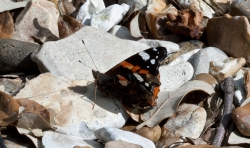 | 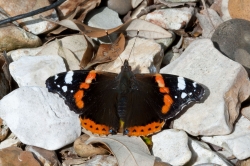 |
| Red Admiral at Browndown Photo © Francis Plowman | Warming-up on the pebbles! Photo © Francis Plowman |
Pig Bush, Near Lyndhurst, New Forest. 1120-1240. Soggy ground, strong breezes and precious little sun augured ill for butterfly joy. For sure it appears too early to see any Grayling but Silver-studded Blue put in a surprising but most welcome appearance! Three females (very diminutive creatures they were) and at least ten males were counted. The site of the three females was at least 300 metres from where the males were gathered. All were close to pink heather and most were feeding. Other butterflies counted: Meadow Brown (2); Small Heath (2);Large Skipper (1). [Posted by Francis Plowman]
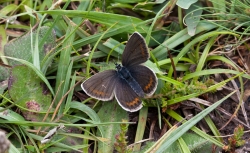 | 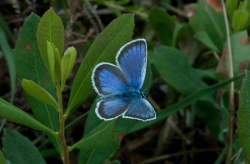 |  |
| Silver-studded Blue female Photo © Francis Plowman | Silver-studded Blue - very fresh male Photo © Francis Plowman | Silver-studded Blue male Photo © Francis Plowman |
ESSEX skipper at Gosport Ramparts.. At Gosports Ramparts(No 1 Bastion),14:30-17:30,were a male Essex Skipper(with black tips to its antennae),50 Small Skippers,a Small Tortoiseshell,30 Marbled Whites,10 MeadowBrowns and 3 Silver Y Moths,basking or taking nectar from red clover,white clover,cat's-ear,or creeping thistle. [Posted by Dr David Tinling]
Hawkhill Inclosure. After visiting Yew Hill yesterday, we thought, while the ‘good’ weather held out, we’d go back to Hawkhill to see if the single Silver Studded Blue we found on the 17th had some friends.
We got there about midday and found Blues as soon as we came out of the car park. Very good numbers now of males and females. The females are already looking very worn in some examples. The males are still mostly fresh examples. Very windy so hit and miss with the pictures. We also saw a Ringlet, 10-15 Meadow Browns, mostly inside the enclosure by the old bomb dump on bramble flowers, 3 Small Heaths and 5 Large Skippers. Unfortunately, we didn’t see any Fritillaries.
We left about 2pm and got home just as the heavens opened! Good timing! [Posted by Tracy Piper]
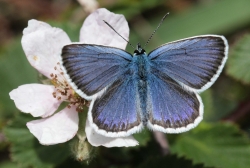 | 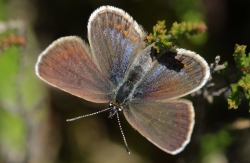 | 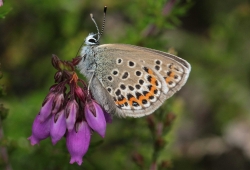 |
| Silver Studded Blue posing nicely Photo © Tracy Piper | Female with nice sprinkle of blue scales Photo © Tracy Piper | Female underside Photo © Tracy Piper |
Hawkhill Inclosure. ....Some more pictures [Posted by Tracy Piper]
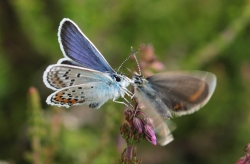 |  | 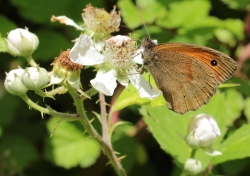 |
| Male flirting with female Photo © Tracy Piper | Very woolly looking Small Heath Photo © Tracy Piper | Meadow Brown nectaring on bramble Photo © Tracy Piper |
Silver washed Fritillary at Straits Inclosure. This morning( 9.30 - 10.45pm ) I visited Straits Inclosure. A sunny start was soon followed by white cloud.
Soon after my arrival what appeared to be a White Admiral flew across the ride from the canopy of one oak tree to another but I hesitate to record this as a positive sighting.
Other butterflies seen were Ringlets 18; Meadow Browns 12; Large Skippers 8; Speckled Woods 3; Red Admirals 2; Green veined White 1.
Having completed the shopping, I returned about 12 o'clock for a final look since by then there were now sunny intervals and higher cloud. During a quick trip to the second tower I was pleased to see 7 Silver washed Fritillaries making my return well worthwhile , although sadly no White Admirals! [Posted by Hazel Pratt]
Milton Foreshore and Nature Reserve. With the advent of a lot of rain coming in from the south-west by 2:00pm of which as I write this there seems very little evidence of this and I should have been in and amoungst it at Alice Holt Forest as the Purple Emperor is out in Surrey and Sussex, I held back and went to my local patch instead which produced the best counts of butterflies for the season in 2016,which were as follows:Marbled White (12) females were bombing the grasses with eggs, fascinating to watch...Meadow Brown (20) Small Tortoiseshell (1) Comma (1) Large White (2) Small White (12) Holly Blue a female which was observed laying eggs on Bramble blossom heads which had not opened yet, this is an observation I've never noted before, I have found no references to this species using this species of plant. This is why I was glad I never ventured into the depths of the Hampshire Surrey border! Also seen were Large Skipper (2) [Posted by Ashley Whitlock]
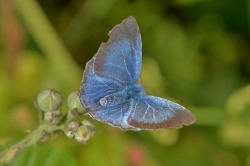 | 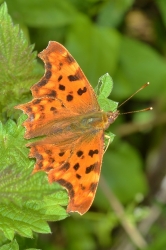 | 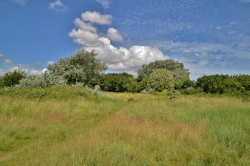 |
| Female Holly Blue utilizing Bramble as a host for egg-laying Photo © Ashley Whitlock | Comma Photo © Ashley Whitlock | Milton Foreshore Nature Reserve Photo © Ashley Whitlock |
Hayling Billy Cycle Path Gatekeeper. I have just received and edited here in Cornwall, the latest batch of photos my father, Roy Symonds has recently taken, including the Gatekeeper seen on the Hayling Billy Cycle Path. The first sighting in the county? [Posted by Richard Symonds]
Browndown Coastal Area, Elmore. 1220-1335. With red flags flying to deny access to the Browndown military training area (and planned to remain flying until 30 June 2016) I walked the adjacent Browndown Coastal Area; essentially a narrow strip of unkempt meadow with wild shrub/bush borders with a few trees on the southern perimeter but with grass pathways. Small Tortoiseshell (2); Small White (1); Marbled White (18); Meadow Brown (7); Large Skipper (7). [Posted by Francis Plowman]
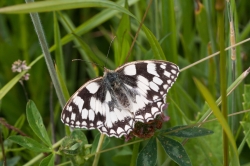 | 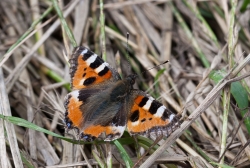 | 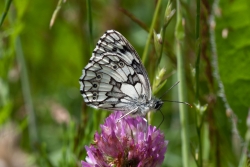 |
| Marbled White Photo © Francis Plowman | Small Tortoiseshell Photo © Francis Plowman | Marbled White male Photo © Francis Plowman |
Monks Hill and Seafield Park. 1499-1500. Large Skipper (2); Meadow Brown (9); Marbled White (12); Small White (1). The Monks Hill shore was too blustery for any butterflies. [Posted by Francis Plowman]
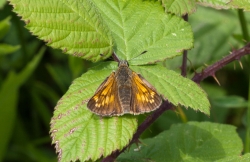 |
| Large Skipper female Photo © Francis Plowman |
Alver Valley Country Park (Chark). 1510-1610. The new pay to park facility now open at the Chark end of Lee on the Solent. A new pay to park area is also under construction at the eastern (Grange Road) access to previously common land. Meadow Brown (26); Marbled White (15); Large Skipper (14); Small Tortoiseshell (1); Common Blue (1). [Posted by Francis Plowman]
 | 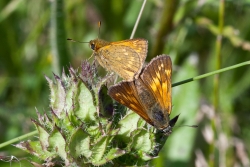 |
| Meadow Brown Photo © Francis Plowman | Large Skipper Photo © Francis Plowman |
Monks Wood, Elson, Gosport. 1620-1640. Meadow Brown (9); Red Admiral (1); Holly Blue (1); Large Skipper (2); Marbled White (2). I include the shot of the tatty Red Admiral since I see so few. [Posted by Francis Plowman]
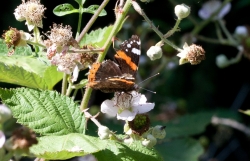 |
| Red Admiral Photo © Francis Plowman |
Hayling Billy Cycle Path. Today I did a local walk, walking the length of the Hayling Billy Cycle Path on Hayling Island from the old railway bridge (SU717039)to the Hayling Theatre in West Town (SZ709999). Temperature was 19 degrees. Good numbers of Marbled Whites were seen on the chalk based areas to the North, and I was pleased to see my first Gatekeeper of the year just South of the North Hayling Halt car park. Totals: Large White 2, Small White 20, Holly Blue 3, Meadow Brown 36, Marbled White 22, Gatekeeper 1, Red Admiral 4. [Posted by Roy Symonds]
Yew Hill. After a few unsettled days, today promised to be much better, so Tracy and I headed off to Yew Hill for our second trip there this year. It was warm with sunny spells, and we were rewarded with a lot of butterflies. Most prominent were Marbled Whites – there were 100s of them both on the fields leading to the reserve as well as the reserve itself. Also present in large numbers were Meadow Browns and Ringlets. We also saw Large Skipper (15+), Small Skipper (5), Small Heath (8), Brimstone (1m), Green Veined White (1), Large White (2), Small Tortoiseshell (5), Speckled Wood (4), and one late male Common Blue. We searched in vain for White-letter Hairstreaks, but it was not to be. Gives us something to aim for on our next visit! [Posted by Dave Grubb]
 |  | 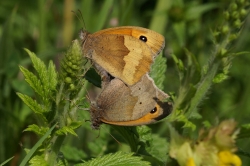 |
| Marbled White Photo © Dave Grubb | Ringlet Photo © Dave Grubb | Mating Meadow Browns Photo © Dave Grubb |
Yew Hill. Some more photos from Yew Hill [Posted by Dave Grubb]
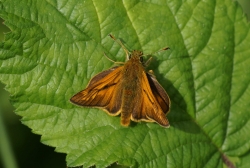 | 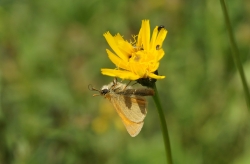 | 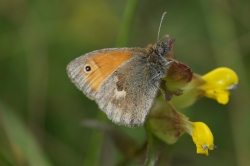 |
| Large Skipper Photo © Dave Grubb | Small Skipper Photo © Dave Grubb | Small Heath Photo © Dave Grubb |
Dark Greens On Pitt Down. An early afternoon visit to Pitt Down produced 6 Dark Green Fritillaries including a stunning female, all voraciously feeding on thistles. Most of the males were fresh, except one which was slightly faded. I did not have time to count numbers of other species, however Brimstone, Marbled White, Large Skipper and Meadow Brown were also present. [Posted by Alan Thornbury]
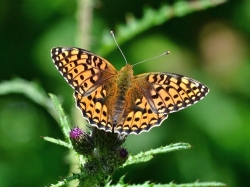 | 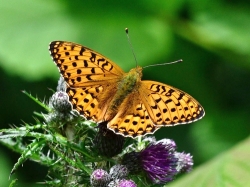 | 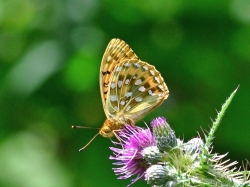 |
| Dark Green Fritillary (Female) Photo © Alan Thornbury | Dark Green Fritillary (Male) Photo © Alan Thornbury | Dark Green Fritillary (Male) Photo © Alan Thornbury |
Fritillary at large. A brief visit to the Boarhunt woods near Bere Farm yielded a single male Silver-washed Fritillary nectaring on the bramble flowers in an even more brief spell of sunshine. Other species comprised only Meadow Browns and a G V White. [Posted by Andrew Brookes]
Duke of Burgundy Larvae Hunt Butser Hill. Standing in the car-park today I had no Idea what was in store, in fact I was half minded to call it off as the cloud cover was intense and the grass was saturated. However Im glad I didn't as the field trip was one of the most 'bizarre' and eye opener Ive ever had the pleasure to be part of. We started our search on the West side of Butser this is where Ive seen a lot of female Duke of Burgundies this year. We saw 5 species in the first five minutes of being on site, which bode well for the rest of the day. We could see some blue sky and the sun did come out many times and the temperature shot up. We saw many leaves of Cowslips with the familiar 'gun-shot' holes in them, and were really successful with finding up to 7 larvae. One Cowslip plant had three larvae all on three separate leaves. Most of the Larvae were in the first instar where they quite translucent in colour, and hadn't turned a nice colour of green with the leopard spots down the sides. Why I say it was a bizarre walk is the fact we saw a Grizzled Skipper in good condition feeding on Bramble blossom which Id never seen before, we also saw a Orange Tip as well, the latest I've ever seen one. We also copped Small Skipper as well, a pair of mating Large Skippers, and the lovely Dark Green Fritillary was patrolling up and down the hills side as well, we also nearly trod on a sleepy Elephant Hawk Moth and we had to make an effort to get it on to a leaf out of harms way, it was certainly playing dead.Totals were as follows: Dark-Green Fritillary (5) Common Blue (13) Small Heath (50) Red Admiral (2) Large Skipper (20) Meadow Brown (50+) Speckled Wood (1) Ringlet (3) Marbled White (3) Grizzled Skipper (1) Orange Tip (1) Small Tortoiseshell (4) Brown Argus (2) Small White (2) Burnet Companion (5) Speckled Yellow (1) Yellow Shell (2) Common Carpet (1) Silver-'Y' (2) 6 Spot Burnet Moth (50+) Elephant Hawk Moth (1). I d like to thank the ever faithful for coming and making this field just what it was fantastic! [Posted by Ashley Whitlock]
 | 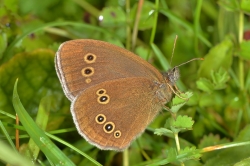 | 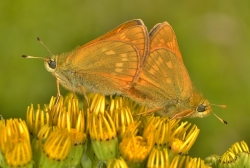 |
| Duke of Burgundy Larvae on cowslip leaf Photo © Ashley Whitlock | Ringlet Photo © Ashley Whitlock | Large Skipper mating Photo © Ashley Whitlock |
Shatterford New Forest. In between the torrential downpours an afternoon visit to Shatterford in the New Forest found at least a dozen Silver-studded Blues on the wing in the heather, no other butterflies were seen. http://awayfromfourmarks.blogspot.com/ [Posted by Chris Rose]
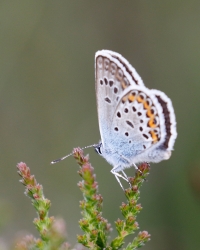 | 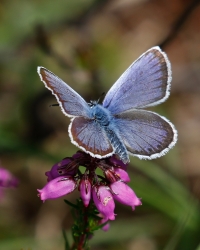 |
| Silver-studded Blue Photo © Chris Rose | Silver-studded Blue Photo © Chris Rose |
Martin Down. A visit to Martin Down found the Marbled Whites and Meadow Browns out in force, joined by four Dark Green Fritillaries, and singles of Adonis, Common and Small Blue, As well as the butterflies there were excellent views of at least eight singing Turtle Doves and Common Spotted, Bee, Pyramidal, and Fragrant Orchids. [Posted by Chris Rose]
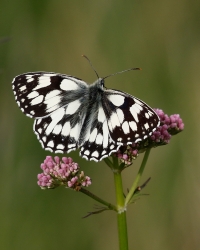 |  |  |
| Marbled White Photo © Chris Rose | Adonis Blue Photo © Chris Rose | Dark-green Fritillary Photo © Chris Rose |
in a short sunny spell in southampton. pear tree green wooolston: on a short visit managed to see three white-letter hairstreak
along with 8 marbled whites in a short sunny spell [Posted by chris piatkiewicz]
Woodland foray. Had a look a Straits Inclosure and Abbots Wood this morning in anticipation of the Emperor season beginning and it was pleasing to see that the FC had not mown the rides this year. At Straits some Sallow saplings are gradually coming back but the main ride is still way below its former glory with less than twenty mature trees, many of them not suitable for egg laying. At Abbots some of the Sallows around the young conifer plantation are certainly becoming viable and it will be interesting to see how this wood fares. No Silver Washed or White Admiral were seen but Ringlet and Large Skippers were building nicely. I don't think we will see his highness until the first week of July here. On the way back I popped in to Broxhead Common where good numbers of Silver Studded Blue were flying but the afternoon rain sent them - and me - scurrying for cover. [Posted by Mark Tutton]
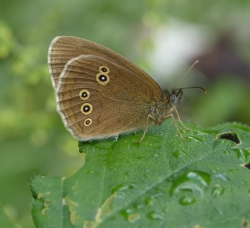 |  | 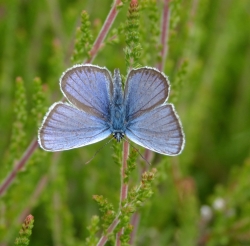 |
| Fresh Ringlet Photo © Mark Tutton | Silver Studded Blue Photo © Mark Tutton | Silver Studded Blue Photo © Mark Tutton |
Wooton Coppice.. Seen at Wooton Coppice, New Forest from 12.30-15.00 were Small Skipper 1, Large Skipper 4, Marbled White 3, Meadow Brown 5, Ringlet 3, Silver Studded Blue 1 (in the middle of a wooded area!) [Posted by Mark Pike]
 |  | 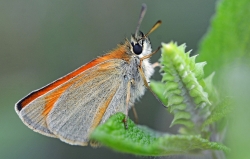 |
| Marbled White Photo © Mark Pike | Marbled White Photo © Mark Pike | Small Skipper Photo © Mark Pike |
Hawkshill Blues. A visit to Hawkshill, New Forest between 10.30-12.00 produced 15-20 Silver Studded Blues, mostly very fresh and surprisingly mobile given the cool breeze and odd heavy shower. Also seen were 8 Meadow Browns and 5 Large Skippers. [Posted by Mark Pike]
 | 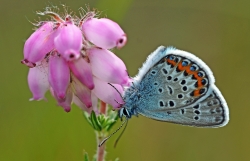 | 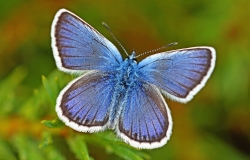 |
| Large Skipper Photo © Mark Pike | Silver Studded Blue Photo © Mark Pike | Silver Studded Blue Photo © Mark Pike |
Clouded Yellow at Hillier Gardens. Surprised to see a clouded yellow flying near the visitor centre at Hillier Gardens this morning, before the showers started. That apart a couple of ringlets and single speckled wood, meadow brown and marbled white were all we encountered in a 3 hour visit. [Posted by Rupert Broadway]
Chalton Down Marbled White. Just received and edited here in Cornwall, the latest photos taken by my father, Roy Symonds, including this Marbled White seen at Chalton Down. [Posted by Richard Symonds]
Chalton Down. Visited Chalton Down (SU736156) today before making a trip to Iping/Stedham Commons. Here Meadow Browns are increasing in number and saw my first Marbled Whites this year which were in good early numbers. Totals: Large White 1, Meadow Brown 38, Meadow Brown 34, Small Heath 8. [Posted by Roy Symonds]
Gosport Shores. Haslar Sea Wall Car Park Scrub. 1440-1430. Small Tortoiseshell (1); Large Skipper (5); Meadow Brown (2); Marbled White (2) and Painted Lady (1). Doubtless the 'Brexiteers' will in due course unveil a way of retarding such attractive immigrants to our shores! :)
Gilkicker 1440-1500. Notwithstanding a strong SW breeze a few butterflies were enduring a miserable June (along with the rest of us!): Marbled White (males)(4); Large Skipper (3); Small Heath (2).
Alver Valley Country Park (West of river) 1510-1610. This perambulation - ostensibly to check on any sign of White Admiral - required de-socking and a lengthy and uncomfortable paddle through the flooded Alver in order to negotiate Apple Dumpling Bridge. Sadly such fortitude was unrewarded in terms of the walk's object but the following were noted: Comma (4); Large Skipper (3); Speckled Wood (1); Meadow Brown (3) and Marbled White (1).
Monks Walk (Frater Road) Elson. 1620-1645. Small Tortoiseshell (1); Meadow Brown (7); Comma (1); Large Skipper (5).
Where's summer? [Posted by Francis Plowman]
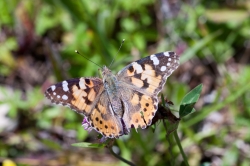 |  | 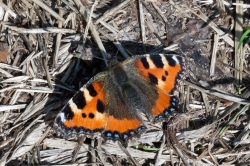 |
| Haslar (welcome) immigrant! Photo © Francis Plowman | Speckled Wood at Alver Valley Photo © Francis Plowman | Small Tortoiseshell at Monks Walk Photo © Francis Plowman |
Hummingbird Hawk Moth. In the garden in Lordswood and at around 12 noon a Hummingbird Hawk Moth appeared for around 20 seconds around Red Valerian and other nectar flowers. [Posted by David Lobb]
Magdalen Hill Down. I visited MHD today from midday to 1.30 pm. The weather was cloudy with sunny intervals and in spite of the strong southerly wind I was pleased to find the following species: Painted Lady 2 (one of which was very worn); Brimstone 3 (1m 2f); Small White 1; Common Blue 5(4m 1f); Meadow Brown 20+; Marbled White 25+; Large Skipper 8; Small Blue 5; Small Tortoiseshell 1; Ringlet 1; Small Heath 1. [Posted by Hazel Pratt]
Portsdown Hill. Following on from Mark's report about migration, it certainly looks as if there has been a heavy influx of Silver'Y' Moths on Portsdown Hill today. I concentrated my efforts in between Fort Widley and the Hospital as this is where I've seen the Dark Green Fritillary in recent years although today I was out of luck. It was very windy but there were good numbers of Marbled White and Meadow Brown. There wasn't a lot else which is exceptionally poor for the end of June. Counts were as follows: Comma (1) Marbled White (30+) Meadow Brown (50+) Large Skipper (1) Painted Lady (4) Small Tortoiseshell (1) Silver 'Y' (12-15) [Posted by Ashley Whitlock]
 | 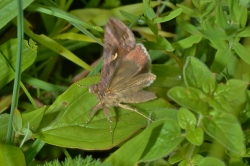 | 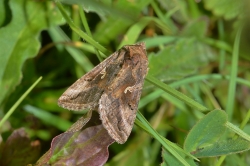 |
| Female Marbled White on Knapweed Photo © Ashley Whitlock | Silver'Y' Moth on take -off! Photo © Ashley Whitlock | And at rest Photo © Ashley Whitlock |
Migration underway?. A lunchtime walk around Sandy Point lifeboat station revealed that the warm thundery weather had encouraged a few migrants, about 30 Silver Y moths were refuelling on any available nectar source and best of all there was a lovely fresh Helice Clouded Yellow. Good numbers of other butterflies were active in the cloudy humid conditions including Marbled White, Meadow Brown,Large Skipper, Common Blue and Holly Blue. No pictures because I forgot my camera! [Posted by Mark Tutton]
Foxlease Meadows North SU831571. Dark Green Fritillary, fresh, Marbled Whites c10, Meadow Browns 50, Skippers, despite drizzly weather. [Posted by David Buckler]
Purple Hairstreak. Saw my first Purple Hairstreak of the year high in an oak in the garden in Christchurch this evening. They appear in exactly the same spot, in the same oak every year. Last year they appeared on 24th June. [Posted by Mike Gibbons]
Monks Wood, Elson, Gosport. Returning home to the coast the sun was shining and so a brief walk around Monks Wood (1545-1610) would conclude my day out. The following butterflies were seen: Meadow Brown (14); Small White (4); Large Skipper (2); Comma (1); Common Blue (M)(1). Many nettles were crawling with Peacock caterpillars of various sizes. [Posted by Francis Plowman]
 |  |
| Small White Photo © Francis Plowman | Comma Photo © Francis Plowman |
Noar Hill. From 1330-1445 I circulated around Noar Hill; it was grey, overcast and chilly. The fantastic display of wild flowers particularly orchids is well worth seeing. Unsurprisingly few butterflies were noted. The following were recorded: Small Heath (8); Common Blue (M)(1); Speckled Wood (3); Large Skipper (2); Meadow Brown (1); Ringlet (1); Marbled White (2). Not all obliged the camera! [Posted by Francis Plowman]
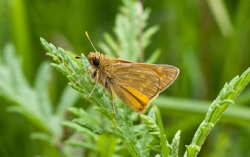 | 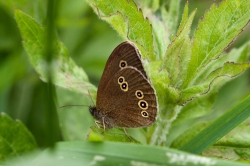 |
| Large Skipper Photo © Francis Plowman | Ringlet Photo © Francis Plowman |
Old Winchester Hill. From 1045-1245 a slow walk around the top of the hill and then the steep descent to the valley and return (even steeper!) realised a count of eight species. Under grey clouds and cool breeze with temperature around 16 degrees I was surprised to see so many. I counted: Meadow Brown (10); Small Heath (8); Large Skipper (4); Common Blue (3); Marbled White (3); Small White (1); Brimstone (F)(1)(M)(1); Small Tortoiseshell (1). The Marbled Whites were very fresh and feeding; the female Brimstone was enormous! [Posted by Francis Plowman]
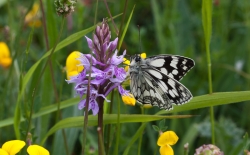 | 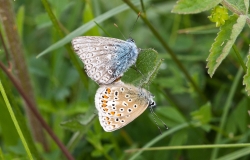 | 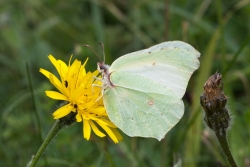 |
| Marbled White Photo © Francis Plowman | Common Blue Photo © Francis Plowman | Brimstone (female) Photo © Francis Plowman |
Havant Thicket. On a day with some sunny spells and temperature of 17 degrees, I chanced my luck in Havant Thicket. A poor turnout with just Meadow Brown 9, Small Tortoiseshell 1 and Large Skipper 1. [Posted by Roy Symonds]
Dark green fritillaries, Stockbridge Down. Paid a brief visit to Stockbridge Down this morning, 2 very fresh Dark Green Fritillaries seen, one posed for a picture - see attached. [Posted by Kevin Haggar]
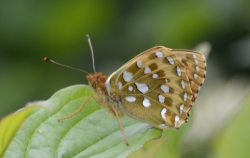 |
| Dark Green Fritilary Photo © Kevin Haggar |
IBM Lake, Cosham. My first White-letter Hairstreak of the year in the usual elms along the northern perimeter of the site this morning. Marbled White, Meadow Brown and a Small Tort too. [Posted by Tim Doran]
Hawkhill Enclosure 1.30 pm -3.00 pm. After the torrential rain and thunderstorms yesterday, we were a bit mad to take the decision of going out to Hawkhill Enclosure for a quick look around. The eternal optimist in us wanted to see if there were any Silver-studded Blues around yet. The realist in me thought if we didn’t get struck by lightning we would probably get soaked! Despite being sunny-ish in Chandler’s Ford when we left it got increasingly dark and foreboding the closer we got to the New Forest.
We parked in the car park there and wandered through the wood for a short while before coming out and looking along the edge. We saw an orange coloured butterfly briefly but couldn’t honestly identify it. No sooner had we come out of the wood and the heavens opened and we dived back under the trees! The shower passed and we ventured out again, not really expecting to see anything. I wandered over to a strange looking plant amongst the orchids and heather and got a big surprise when I realised there was a Silver-studded Blue male sitting on it!! Dave thought I was joking when I shouted ‘I found one!!’ After taking a few shots we wandered around trying to find some more. There were none! No matter how hard we looked we found no others in the surrounding area. Could this be the first one to emerge? It is very early for them but I can’t believe we picked the right day to find one of the first! We went back to the lone male and spent a happy hour watching, photographing and following him when he decided to fly. He even sat on my finger briefly, trying to get warm maybe. Despite being dark and damp we did manage a few decent pictures. The sun almost came out which was enough to make him open his wings for us.
I will never worry about not seeing any butterflies on a rainy day again! [Posted by Tracy Piper]
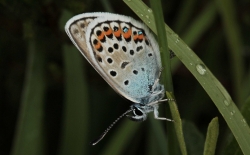 | 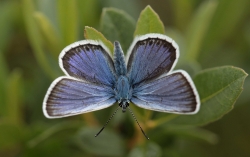 |  |
| Sheltering from the showers Photo © Tracy Piper | Beautiful, fresh Silver-studded Blue Photo © Tracy Piper | Sitting on my finger Photo © Tracy Piper |
Adanac Park SU373157.... again. Went for another walk here today during my lunchbreak. this time no camera, so I could concentrate on counting. Much better weather today with quite hot sunny spells. The walk took in the hay meadow, hedgerows and woodland edges from about 13.15pm to 14.00
Count was 15 Large Skipper, 10 Meadow Brown, 1 Painted Lady, 1 Red Admiral, 1 Speckled Wood and 2 Mother Shipton Moths [Posted by Tracy Piper]
North Hayling Cycle Path. Walked halfway along the North Hayling Cycle path towards the old railway bridge (SU7103) on North Hayling where I saw my first Large Skippers this year. Totals: Small White 1, Holly Blue 1, Meadow Brown 5, Large Skipper 3. [Posted by Roy Symonds]
Adanac Park SU373157. Took my camera to work today because I saw a couple of Large Skippers yesterday that a colleague had mentioned. I wandered over to my favourite spots between 12.30 and 13.30. Despite the threatening black clouds, strong, gusty winds and my hair blowing in front of the camera because I forgot to tie it back! I mangaged to get some pretty good shots!
I found around six Large Skippers mostly feeding on white and red Clover and Willowherb like flowers or just sitting on grass trying to shelter from the wind. I also saw a lovely Mother Shipton moth which got blown away before I could get a shot. There were 4 Meadow Browns which are slowly increasing in number. (Saw only one last week) and a lone Speckled Wood.
Not bad considering the windy and occasionally wet weather this week.
I wish I could win the lottery and buy the land next to Ordnance Survey because it has the potential to be a really good butterfly reserve. Pity that it may get built on in the near future.
Over the last year or two here I've seen all the whites, Orange Tips, Clouded Yellows, Brimstones Small and Large Skippers, Small Coppers, Speckled Woods, Common Blues, Holly Blues, Red Admirals, Peacocks, Small Tortoiseshells, Painted Ladies, Commas, Gatekeepers, Brown Argus, Marbled Whites and Meadow Browns. I will endevour to enjoy it while I can. [Posted by Tracy Piper]
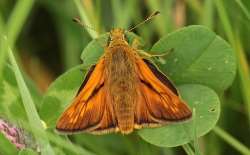 |  | 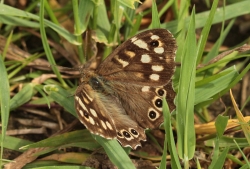 |
| Large Skipper Photo © Tracy Piper | Meadow Brown Photo © Tracy Piper | Speckled Wood Photo © Tracy Piper |
1976 Remembered: The Wall Brown. Forty years ago the Wall Brown, now a rare butterfly in Hampshire, produced a remarkable first brood. During the early to mid 1970s it was frequently encountered in a variety of habitats, though generally only in ones and twos. It enjoyed an excellent year during the warm dry summer of 1975, producing a strong third brood that autumn.
In 1976, in East Hampshire, the brood started to appear around May 10th (one at Noar Hill), and fizzled out in mid-June (my last record is of 5-6 on Butser Hill on June 14th).
It late May it was one of the most numerous butterflies on downs and along sunny woodland rides. I counted >50 in Alice Holt Forest Lodge Inclosure on May 23rd, 40 at Noar Hill on May 27th, and 30 in the Oakhanger woods on the 28th. It was also seen in low numbers along many road verges and earthy banks in pasture fields. [Posted by Matthew Oates]
Portsdown Hill Field Trip. The weather today was not your typical butterflying weather with a chance of rain and it was raining on and off all be it only lightly, I was surprised by the good turn out today. We all persevered with it and we were all pleasantly surprised with what we all saw. In the hedgerows alongside the top of the downland, Meadow Browns occasionally appeared and the Large Skipper kept us on our toes, also there were good amounts of Great Green Bush Crickets and other Grasshoppers and their nymphs. In the main area of the old chalk pit workings there were good amounts of Marbled White and the odd Small Blue to keep us all happy. All in all it was a pleasant walk and we saw more than could be expected the totals were: Marbled White (10) Common Blue (7) Small Tortoiseshell (2) Meadow Brown (15) Large Skipper (6) Holly Blue (2) Small White (2) Brimstone (2) Silver 'y' Moths, Mother Shipton Moths Burnet Companion (6) Yellow Shell (1) Cinnabar Moth (5). We also saw lovely Bee Orchids, and Pyramidal Orchids, and great swathes of Kidney Vetch, Horseshoe Vetch, and Birds-Foot Trefoil. I want to thank all those who were brave enough to come, as it seems butterflies don't always fly in sunny weather! [Posted by Ashley Whitlock]
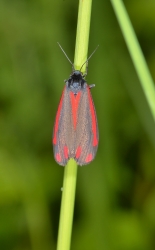 | 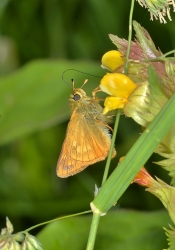 | 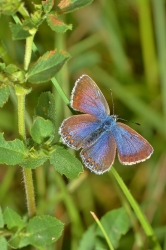 |
| Cinnabar Moth Photo © Ashley Whitlock | Large Skipper feeding on Yellow Rattle Photo © Ashley Whitlock | Female Common Blue Photo © Ashley Whitlock |
Magdalen Hill Down, Winchester. Two hours (1110-1310) under diffused sunshine and light breeze MHD was circulated to the following effect: Green Hairstreak (3); Common Blue (11); Orange Tip (M)(3); Large Skipper (2); Small Blue (29); Brimstone (F)(2); Small Heath (1); Meadow Brown (3); Painted Lady (1). [Posted by Francis Plowman]
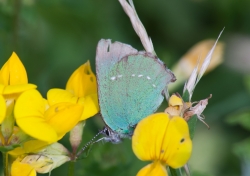 | 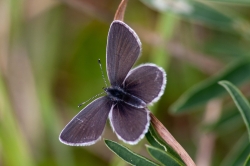 |  |
| Green Hairstreak Photo © Francis Plowman | Small Blue (Male) Photo © Francis Plowman | Small Blue Photo © Francis Plowman |
West Butser Hill. Went to this site just to see if the Duke was still flying and to my surprise it was, its been one of the longest flight periods I've ever known since 2014 when I saw it in 5 months..April,May,June,July and August. There were two and these were still in very good condition, and I suspect there are still plenty still on the wing throughout the Butser Hill area. Other species on the wing were Small Heath (35) very common now Grizzled Skipper (4) again in very good condition, Large Skipper (3) Red Admiral (1) Green Hairstreak (1) Dingy Skipper (1) Brown Argus (1) 6-Spot Burnet Moths were everywhere, and Burnet Companions Yellow Shells, and also heard the Cuckoo again which is the latest Ive ever heard it. [Posted by Ashley Whitlock]
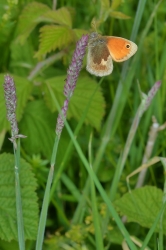 | 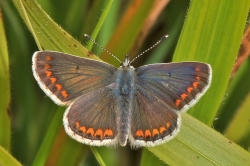 | 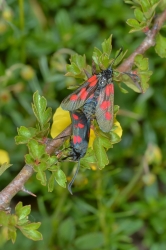 |
| Small Heath Photo © Ashley Whitlock | Brown Argus Photo © Ashley Whitlock | Six-Spot Burnet Moths mating Photo © Ashley Whitlock |
Monks Wood, Elson, Gosport. The local council have been at work recently mowing a perimeter path around this field, ripping-off 2-3 feet of woodland edge whilst leaving the central field under high grass. There is still some vetch and clover to be seen while other patches have disappeared completely under the mower! Notwithstanding, the field area is dry and was today warm and sunny. Between 1120-1220 it sustained the following: Meadow Brown (3); Common Blue (F)(2); (M)(1); Large Skipper (1); Painted Lady (1); Speckled Wood (2). The blues were showing signs of wear and tear but the Meadow Browns were fresh and lively. [Posted by Francis Plowman]
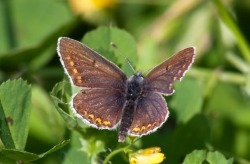 | 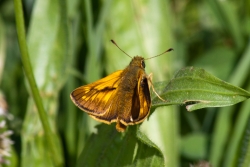 | 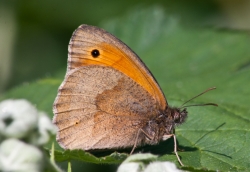 |
| Common Blue female Photo © Francis Plowman | Large Skipper Photo © Francis Plowman | Meadow Brown Photo © Francis Plowman |
Marsh Fritillary at Martin Down. Our first Marsh Fritillary at Martin Down today plus lots of Small Blue, Common Blue and Adonis Blue with one or two Meadow Brown. [Posted by Roy & Sara Cowley]
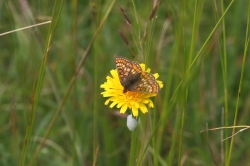 |
| Marsh Fritillary at Martin Down Photo © Roy & Sara Cowley |
Martin Down Blues. Having been confined indoors for the last 3 days (the best of the summer by a distance) I finally got out today and decided to make the longish trip to Martin Down. There to be greeted by low cloud and mist! Nothing for the first hour (except turtle doves and yellow hammers which were wonderful - but not what I came for) - then the sun came out at 1230 and the place was transformed. More small blues than I've ever seen anywhere else, plenty of Adonis Blues near the top of the hill (including 1 female), a few common blues, my first large skipper of the year and also my first meadow browns. A single (and pristine) grizzled skipper, plenty of small heaths and brimstone. If there was something missing it was a fritillary but that's being picky - I guess the small marsh population here has about finished and its just a bit early for dark greens. A wonderful day. Hope I've got the id correct for the 3 blues below (they certainly looked much different in the field) [Posted by Mark Wagstaff]
 |  | 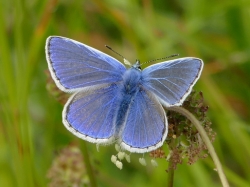 |
| Small Blue Martin Down Photo © Mark Wagstaff | Adonis Blue Martin Down Photo © Mark Wagstaff | Common Blue Martin Down Photo © Mark Wagstaff |
Compton Chine, Brook Down Isle of Wight. Today was another pilgrimage over to the Isle of Wight going further afield using a car which isn't the cheapest form of butterfly watching to say the least. I decided to look at an old Glanville Fritillary haunt Compton Chine the first place I ever recorded this species in the 1980's. It's changed with many more parts of the cliff face falling into the sea and there looks like a lot of precarious cliff edges where it's about to give way. It's a very fragile looking area, but there is an abundance of Ribwart Plantain all over the site. I then visited another old haunt Brook Down which is part of the new book of walks, and here there was an equal amount of Glanvilles flying rapidly up and down the chalk footpaths. Some of the Painted Ladies encountered were enormous,certainly some of the biggest I've ever seen. Good amounts of Adonis Blues were encountered as well. A lovely Cream Spot Tiger Moth was seen ovi-positing on some grasses. The counts were as follows all sites being collective: Dark-Green Fritillary (2) Painted Lady (27) Small Heath (48) Dingy Skipper (24) Small Blue (43) Large Skipper (23) Adonis Blue (58) Common Blue (70) Glanville Fritillary (28) Brown Argus (5) Meadow Brown (13) Brimstone (4)Large White (1) Green-Veined White (1) [Posted by Ashley Whitlock]
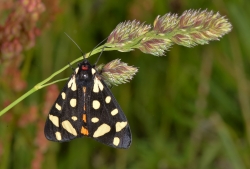 |  | 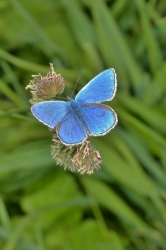 |
| Cream-Spot Tiger Moth Photo © Ashley Whitlock | Glanville Fritillary Photo © Ashley Whitlock | Male Adonis Blue Photo © Ashley Whitlock |
Large White Larva. A few weeks ago noted a clump of 12 yellow eggs on a Honesty plant leaf in my Lordswood garden.These have now hatched and 12 Large White larva have emerged. They are now 9 but getting much larger by the day. [Posted by David Lobb]
Adanac Park SU373157. Took a quick lunch time stroll from Ordnance Survey to see what butterflies may be around in the old deralict nursery NE-ish from OS HQ.
Disappointingly, I saw only one butterfly! It was a Painted Lady, first one I have seen this year. It shot past my ear and dived into a vast spread of Bramble flowers. This was about 13.15pm. It was very hot again as the sun had come out.
Despite there being a large flower filled meadow, deciduous woodland and scrub land containing numerous wild flowers such as Foxglove, Bramble, Buttercup, Ox Eye Daisy, Dead Nettle, Red Campion etc. There was just the one!
I did watch a Kestrel land on the path in front of me though which was a bonus. I wandered round to the other side of the Brambles and caught sight of the Lady a second time but that was it. No camera with me today though. [Posted by Tracy Piper]
Martin Down. Spent a very pleasant - if warm - afternoon walking the Bockerley Dyke at Martin Down specifically to see Adonis Blues and the Burnt Tip Orchid. I am glad to say it was very successful. Adonis were still emerging and looking very fresh, and I spotted at least two very fresh females who were caught by equally fresh males, lots of Small Blues and a single Marsh Fritillary. I counted 25 spikes of Burt Tip orchid which was very pleasing as this is only one of two sites in Hampshire where this beautiful orchid is found. [Posted by Mark Tutton]
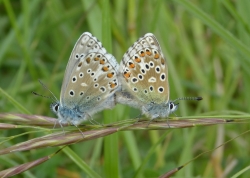 |  |  |
| Mating Adonis Photo © Mark Tutton | Burnt Tip Orchids Photo © Mark Tutton | Male Adonis Photo © Mark Tutton |
Duke Swan-song. In the morning I paid a short visit to West Butser to see how the Duke of Burgundy was faring and it seems that the emergence is has been quite prolonged. I only saw males - about 20 in all but they ranged from very worn being almost transparent, to really quite fresh so they probably have a week to go yet. Green Hairstreak are doing quite well too of which I saw 18 but sad to say that Ash Dieback is a as prevalent here as at just about every site I have visited this year - I fear that there will be no Ash trees to been seen in the UK within the next three or four years - very sad. [Posted by Mark Tutton]
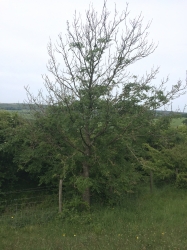 | 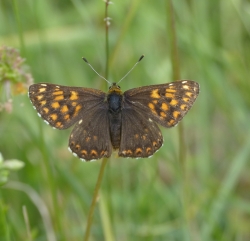 | 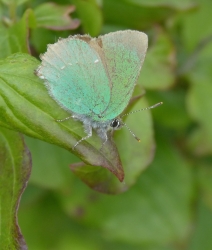 |
| Ash dieback Photo © Mark Tutton | fresh-ish Duke Photo © Mark Tutton | Green Hairstreak Photo © Mark Tutton |
Chalton Down Photos. Some photos of Skippers taken at Chalton Down from my visit on 6th June. [Posted by Richard Symonds]
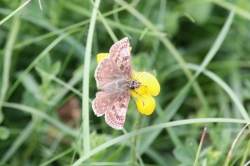 | 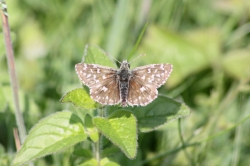 | 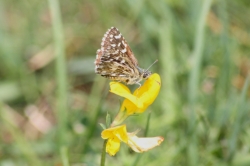 |
| Dingy Skipper Photo © Richard Symonds | Grizzled Skipper Photo © Richard Symonds | Grizzled Skipper Underside Photo © Richard Symonds |
Stockbridge Down. On a trip to Stockbridge Down no Dukes or Pearl Bordered were seen so they must be over.
Brimstone (12) were the most frequent mainly male, Orange-tip(7), Small white(4), Common Blue (4), Small Heath (4), Holly Blue, Green-veined White(2), Grizzled Skippe and a fresh Brown Argus. There were few butterflies near the top of the down but it was very hot. There were many micro moths flying [Posted by Sue Lambert]
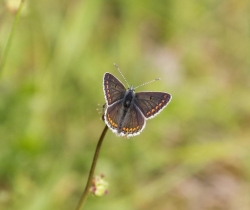 | 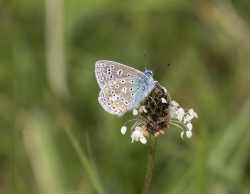 | 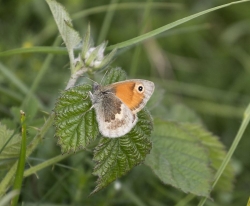 |
| Brown Argus Photo © Sue Lambert | Common Blue Photo © Sue Lambert | Small Heath Photo © Sue Lambert |
Bentley Wood. Had a day off work today so thought we would try a quick visit to Bentley Wood to try and see a Small Pearl-bordered Fritillary. We didn’t get there until nearly mid-day but after heading for the East clearing we saw a few people around. One friendly chap said there was a pair of mating Small Pearls and after he had taken all the shots he wanted, showed us exactly where to find them. After getting down on my front I managed to get a few quite decent shots! Yet another first for us.
What was a pity was that while trying to get these shots a couple of ladies came up and started to also get shots, which is fine but they were getting in my shot and I had to ask them to move a bit. I got a couple more luckily, good shots, then got out of the way to let them have a go. Dave was waiting patiently all this time and we were chatting to the two but one was taking ages and lots of pics. She then said once I get all the pics I can I like to try and move then to a better position! I quietly objected as I don’t agree with poking and prodding butterflies just to get a better pic. Also Dave was STILL waiting to get a pic but she started moving them around and poking them anyway. Surprise, surprise, after she got a couple more shots, they split up and flew off, thus spoiling it for anyone else and poor Dave from getting a decent picture at all.
I really wish that people would NOT poke or interfere with wildlife just to get a better shot! Not to mention thinking of others and not ‘hogging’ an opportunity. If the butterfly is not in the greatest position then such is life. Get what you can and make the most of what you get.
That said, I am still very grateful that we did manage to see some. There were only about 6 or 7 flying around and it was very hot. Also a surprising lack of nectar flowers was not a good sign. The butterflies were desperately trying to find the few sparse clumps of ageing Bugle that were left. We also saw 4 Speckled Woods 3 Brimstones, now very tatty and some Speckled Yellow moths and Burnet companions. [Posted by Tracy Piper]
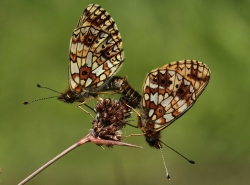 | 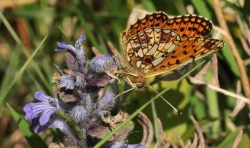 | 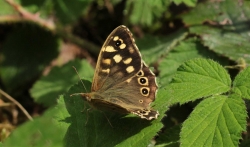 |
| Small Pearl-bordered Fritillaries mating Photo © Tracy Piper | One of very few Bugle flowers left Photo © Tracy Piper | Speckled Wood Photo © Tracy Piper |
Chalton Down, Old Idsworth. Visited Chalton Down (SU736156) today in company with my father, Roy Symonds, before I return home to Cornwall. Here the temperature at its peak reached 23 degrees on the Eastern facing slopes. My target species, here at my favourite site was the Grizzled Skipper and I was lucky to find two fresh specimens, one of which was a female which was ovapositing. Almost all of the Dingy Skippers seen were also looking fresh. A good sign here was the evidence of recent rabbit activity. This follows a few years of low rabbit numbers which resulted in increased grass growth and decreasing numbers of Chalkhill Blues at this site. Hopefully this year numbers may start to improve.
Totals: Brimstone (2M 2F), Large White (3), Small White (1), Orange Tip (2M), Green Hairstreak (3), Common Blue (3M 2F), Holly Blue (5), Speckled Wood (2), Small Heath (10), Dingy Skipper (8), Grizzled Skipper (2). [Posted by Richard Symonds]
Old Winchester Hill. I planned to see the Adonis Blue today at Old Winchester Hill, but alas it still seems to be absent at the moment. Looking at my records from last year it didn't appear here until the middle of June. However I did see a couple of Dukes which was a pleasant surprise, I think this site has a larger colony of this species than most people give it credit for. Other species on the wing were: Small Heath (7) Brimstone (12) Large White (1) Common Blue (25) Dingy Skipper (3) Small Blue (7) again the absence of any obvious Kidney Vetch is a puzzle, a bit like Coulters Dean.... Grizzled Skipper (1) Holly Blue (1) Brown Argus (2) Large Skipper, and a Painted Lady in my garden as I was leaving feeding on my Scabious plants, it was still there when I came home a couple of hours later! [Posted by Ashley Whitlock]
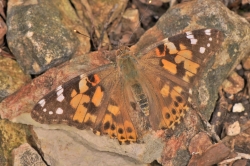 | 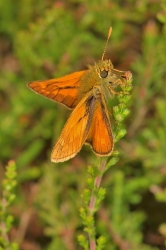 | 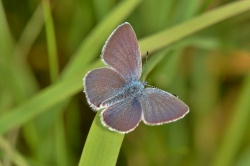 |
| Painted Lady Photo © Ashley Whitlock | Large Skipper Photo © Ashley Whitlock | Small Blue Photo © Ashley Whitlock |
Noar Hill Photos. Returned home yesterday to Cornwall. As promised photos of the Meadow Brown and Small Blue at Noar Hill on 5th June. [Posted by Richard Symonds]
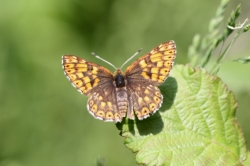 |  |  |
| Duke of Burgundy female Photo © Richard Symonds | Small Blue male Photo © Richard Symonds | Meadow Brown Photo © Richard Symonds |
Trip to Furzleigh Gardens, Minstead. While on a trip to Furzleigh Gardens in Minstead noted a pair of Painted Ladies among the lovely blooms. [Posted by David Lobb]
Yew Hill walk.. Just a quick mention of the walk earlier today, more to follow later!
Six attended under a blue and sun-filled sky, the light breeze in from the E / NE cooling both those present and the more exposed areas of the reserve, this perhaps contributing to the relative lack of lepidoptera recorded.
12 species of butterfly were noted on the wing including three very confiding and photogenic Green Hairstreak, two briefly present and rapidly north-bound Painted Lady, a sunning Dingy Skipper and singles of three further vanessids. Half-a-dozen species of moth included good numbers of Diamond-back Moth, mirroring numbers being noted elsewhere at present, a showy Pyrausta purpuralis and several Burnet Companion.
Of the other invertebrates on site the bee-mimic hoverfly Cheilosia chrysocoma was most notable, though the nymphal Dark Bush-cricket and hundreds of Garden Chafer were probably more appreciated; the latter swarming about both the grassland and hedgerows.
Birds were less troubled by the breeze with raptors particularly prominent, an adult Hobby, three of Sparrowhawk, Kestrel and Buzzard and a Red Kite being seen. Singing Whitethroat, Blackcap and Chiffchaff were evident almost throughout, their song interupted by that of Yellowhammer, Skylark and hedgerow dwellers such as Robin, Wren and Dunnock; Green Woodpecker was also vocal, both before and during the walk.
A Viviparous Lizard briefly showed as it scuttled from the path leading to the reserve entrance, a Fox having been seen on the reserve on the recce. prior to the walk.
Many flower were in bloom with a striking Greater Butterfly Orchid perhaps most appreciated, certainly the most photgraphed. Fragrant and Common Spotted Orchid were also seen, as were Fairy Flax, Scarlet Pimpernel, Knapweed Broomrape, Sainfoin, Yellow Rattle and Columbine, the latter presumably another invader from nearby gardens, where they were seen in bloom.
Thanks must go to the handful of others that attended, their enthusiasm and input helping to make the walk that bit more special, as did the truly summery weather.
Peter. [Posted by Peter E. Hutchins]
Noar Hill. Today in company with my father, Roy Symonds I visited Noar Hill (SU7431) where the temperature reached 22 degrees. My target species was the Duke of Burgundy. After a through search of the site we saw a total of 5 including two which looked very fresh. Most were in areas I had not seen them before.
A surprise was seeing 2 Small Blues at the far end of the first large pit, where I was able to get a photograph should evidence be required! I used to live in Hampshire and visited Noar Hill many times but had never seen Small Blues here before, although I knew that there was a colony here. It will be interesting to know if there have been other sightings here in the past few years. A common species but the first I have seen this year was a single Meadow Brown (again I have a photograph), it was fresh but was already infested with a red mite parasite.
Totals: Brimstone (4F), Large White (2), Small White (2), Orange Tip (2M 1F), Green Hairstreak (8), Common Blue (19M 5F), Small Blue (2), Holly Blue (1), Small Heath (6), Speckled Wood (3), Meadow Brown (1), Red Admiral (3), Peacock (1), Duke of Burgundy (5), Dingy Skipper (3). [Posted by Richard Symonds]
Martin Down. Today we decided to pay a visit to Martin Down to try and find the Marsh Fritillary. This would be another first for us. We parked in the main car park and found it to be really busy. There was some horse riding event on. We made our way towards Bokerley Ditch and no sooner had we started to walk along the top, when Dave spotted a Fritillary. We tried getting a bit closer and managed to get a couple of shots. On closer inspection of the pics we saw it was indeed a Marsh Fritillary! We saw several more as we walked along the ditch and manged a few decent shots too! Mission accomplished!
We carried on for over a mile along this path to see what else was around. Small Heaths were abundant as were Small blues but lesser in number than reported earlier. There are still several Brimstones around and Common Blues are showing good numbers. We found Adonis Blues in a low bowl shaped meadow along with a one Grizzled Skipper. We also encountered a single Green Hairstreak and a pair of Brown Argus’s in a courtship dance. We really thought they would join up but the male flew off after a while. Also a pair of Common Blues mating. Peacocks and Red Admirals also made an appearance. We were there from about 10.15am to 1.15pm and although hazy at first it turned into a very hot day. Well worth getting cooked to see the Marsh Fritillary and another one off our list!
Final rough counts were. Brimstone 10+ mostly females. Small Copper 1. Peacock 3. Red admiral 2. Marsh Fritillary 10. Small Blue 30+. Common Blue 15+ One mating pair, 2 females. Adonis Blue 8 -10 all male. Small Heath 40+. Green Hairstreak 1. Grizzled Skipper 1. Large White 3. [Posted by Tracy Piper]
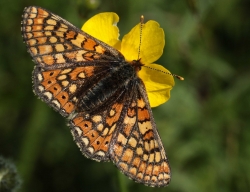 |  |  |
| Marsh Fritillary Photo © Tracy Piper | Brown Argus male chasing female Photo © Tracy Piper | Small Blue male Photo © Tracy Piper |
Martin Down.......more photos. I always take too many photos! I can't help it....more from today's trip. [Posted by Tracy Piper]
 | 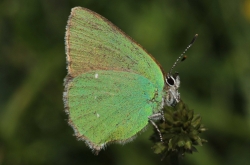 | 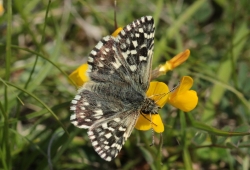 |
| Common Blues mating Photo © Tracy Piper | Green Hairstreak Photo © Tracy Piper | Grizzled Skipper Photo © Tracy Piper |
Large Skippers at Magdalen Hill Down. While showing a small group around Magdalen Hill Down we came across a Large Skipper on two occasions, first in the Extension area down by the road and later at the east end of the Original area. Photo was taken by Carys Jones. [Posted by Bob Whitmarsh]
 |
| Large Skipper, MHD (Extension) Photo © Bob Whitmarsh |
Coulters Dean Field Trip. The weather today was a game of two halves. From the word go it was cool and overcast and we turned up at a packed car-park, I didn't hold out much hope of seeing anything. A walk to Coulters Dean is well in excess of a mile, and on the site we were greeted with lots of Orchids and other wild flowers but without any sunshine there was very little on the wing except a few moths like Burnet Companions. The moment though the sun peeped through the clouds around about 12:00 the temperature shot up and we were greeted with many Green Hairstreaks and Dingy Skippers. All in all it was a successful field trip with as many moths as butterflies, and the total counts were :Green Hairstreak (15) Green-Veined White (3) Dingy Skipper (8) Small Blue (1) Female Common Blue (1) Red Admiral (1) Orange Tip (1) Brimstone (2) Large White (2) Small White (2) Holly Blue (1) Speckled Wood (1) White Ermine Moth (1) Mother Shipton (5) Cinnabar Moth (3) Burnet Companion (11) six-spot Burnet Moth (1) and a rather handsome if not angry Hornet. [Posted by Ashley Whitlock]
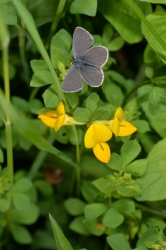 | 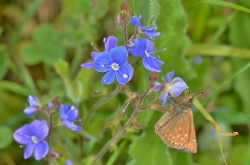 | 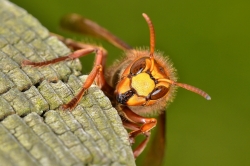 |
| Small Blue but no evidence of Kidney Vetch Photo © Ashley Whitlock | Dingy Skiper feeding on Germander Speedwell Photo © Ashley Whitlock | An angry Hornet Photo © Ashley Whitlock |
Forester moths at Odiham Common. This morning leading a group of Nordic walkers across Odiham Common we stopped to view the early orchids and one of the walkers, Alison Terrey, spotted a Forester. I returned this afternoon and saw a grand total of three, all on the few patches of Ragged Robin. In 2015 my first sighting was 24/5 and the numbers had risen to 28 by today's date so they're about 10 days later. [Posted by Kelvin Richards]
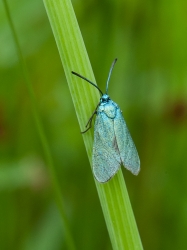 |
| Forester Photo © Kelvin Richards |
Chalton Down Photos. Just returned home to Cornwall and have quickly edited some photos from Chalton Down on 2nd June. [Posted by Richard Symonds]
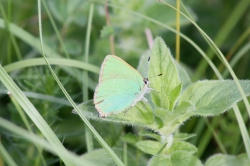 | 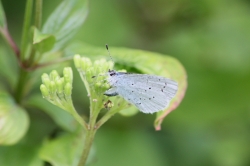 |
| Green Hairstreak Photo © Richard Symonds | Holly Blue female ovapositing Photo © Richard Symonds |
Magdalen Hill Down, 2nd June. A short afternoon visit to the lower slope just above the A31 produced a fair few butterflies on the wing when the sun came out.
Small blues were numerous and included a mating pair. Interestingly, a pristine male was seemingly about to mate with a female when a rather tatty male barged his way in and coupled-up with the female. Well, they say looks don't matter...
Also seen were several common blue and brown argus, as well as one or two grizzled skipper. [Posted by Paul Cox]
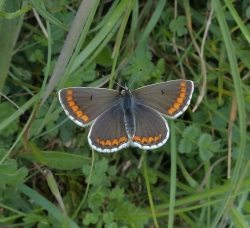 |  | 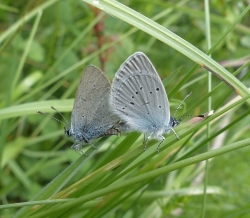 |
| Brown argus Photo © Paul Cox | Mating common blues Photo © Paul Cox | Mating small blues Photo © Paul Cox |
Chalton Down, Old Idsworth. Visiting from my home in Cornwall, my father Roy Symonds and I visited Chalton Down in the late afternoon when the sun finally appeared after a cloudy morning. With low numbers of butterflies starting to fly late in the day when the temperature reached 15.5 degrees, the downland slopes were like Noah's Ark with almost all species seen in pairs. I was happy enough to see my first Brimstone, Dingy Skipper and Small Heath this year. We also watched a female Holly Blue ovapositing on Ivy buds.
Totals were: Brimstone (3M), Small White (2), Green Hairstreak (2), Holly Blue (2), Speckled Wood (2), Small Heath (1), Dingy Skipper (2). [Posted by Richard Symonds]